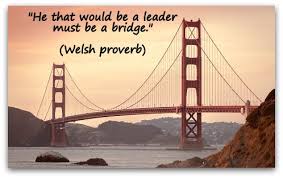 by beCause CEO Nadine Hack – Welsh proverb: “She/he who would be a leader must be a bridge.” What I call engagement leaders are, indeed, “bridges” connecting divergent types of people for the advantage of each and all. They know that deeply engaging internal and external stakeholders in the co-creation of business changes and new initiatives is vital for any strategic action plan to be properly executed.
by beCause CEO Nadine Hack – Welsh proverb: “She/he who would be a leader must be a bridge.” What I call engagement leaders are, indeed, “bridges” connecting divergent types of people for the advantage of each and all. They know that deeply engaging internal and external stakeholders in the co-creation of business changes and new initiatives is vital for any strategic action plan to be properly executed.
Nelson Mandela is an archetypal engagement leader. After 27 brutal years in prison, he emerged as a fervent advocate of engaging with the very people and institutions that oppressed him. When released, he spent the next four years in negotiation with the stalwarts of apartheid. As President, he continued to ensure that all faces and voices were represented in government, business and other institutions.
We can learn much from Mandela, but it would be defeatist to think that one must be extraordinary like him to be a successful engagement leader. The motivation for and value of being an engagement leader in 21st century business should be one’s personal desire to engage with others in order to play a key role in making a positive difference when challenges or opportunities arise, and in our VUCA world, this is an imperative.
Strategic Relational Engagement (SRE)
A broad spectrum of stakeholders has a direct impact on every enterprise’s core business. In today’s increasingly interconnected world, organizations that foster a deep level of connection with their stakeholders are more successful in shaping that impact to their greatest advantage. Fostering meaningful relationships can transform stakeholder fear and/or animosity into understanding.
While SRE is a concept I developed, it has many precedents. Several decades of a growing body of business literature supports the value of team-building, co-creation, consensus among diverse actors and other relational activities for strategic leadership and successful organizational change management. Dr. Martin Luther King, Jr. spoke of the “beloved community.” His belief was that increasing cooperation among allies and winning the friendship of opponents made it possible to live and work together.
King’s idea successfully launched an unprecedented measure of social change. Applying his ideas to business, bridging the gap even among those with opposing views can achieve consensus so each party gains something while the wider society also benefits. For companies, this has become the coveted triple bottom line in 21st century business: people, planet, profit.
When business leaders’ rise above their biases about the capacities, or even validity, of certain stakeholders they engage more effectively with a broader spectrum strengthening decision-making. Some believe status comes from fiercely protecting control and territorial power. But my experience shows that the more inclusive the style of leadership, the greater success the company achieves.
Roadmap Process
When executives learn and embrace the vital mechanisms of relationship-building, businesses can sustain Strategic Relational Engagement and more assuredly solidify long-term success. In doing so, they become engagement leaders. I’ve broken the SRE process down to three main pillars: (I) Create Value through SRE; (II) Overcome Obstacles to SRE; and (III) Sustain SRE for the long-term.
And I’ve mapped each of those into three sub-categories. For example, to create value through SRE, leaders must understand: the capabilities they already have and which they need to acquire; the conditions must create or eliminate; and the processes that will move them forward.
Making an honest, straightforward, assessment of your company’s SRE capabilities, conditions and processes allows you to properly evaluate strengths, weaknesses and untapped resources. As great ideas and insightful observations can come from the most unexpected sources, to begin creating SRE in your company, encourage managers and their teams to do this at each level of your operation.
Successful Techniques
All business leaders want to build on, expand and sustain their company’s success. And, insightful ones know that engaging their internal stakeholders is vital for assuring that there will be buy in and ownership throughout the organization to achieve ambitious (or even basic) goals. While most leaders usually have explicit frameworks for other internal processes, they often do not have a clear engagement action plan.
You must create concrete structural support. This can’t just be an individual initiative but must be woven into the fabric of how your company operates internally. To do so, you have to develop systematic mechanisms that value and reward stakeholder collaboration.
There here are some core fundamentals. Creating trust is absolutely foundational, which you can build by listening and being open to other’s input. I have helped many organizations try these steps, making course corrections as they engage and learn what works best for them.
Best Practices
In a TEDx talk I gave in Geneva, “Adversaries to Allies” I used an example 40 years ago that I chose because connections forged in 1977 still yield amazing results today. Anyone who’s interested to hear it can find the YouTube video at this link.
Essentially, four groups who were bitterly antagonistic – government leaders, community organizers, environmental activists and the logging industry – came together on a sustainability initiative long before the term renewable resource was in the common lexicon. How was this possible?
Because we helped them all be absolutely clear on exactly how they’d benefit. And then we had to remind each stakeholder – at many times – to refocus on the clarity of why they chose to engage. This seems so obvious but I can’t tell you the number of times I’ve seen collaborations fail because people simply weren’t really clear to each other – or even themselves – about their expectations.
Social Media
To be successful in today’s world, where diverse stakeholder boundaries expand daily – and exponentially – it is imperative for leaders to build and strengthen relationships even among those who may initially mistrust each other, or who simply have never worked together in the past.
This actually always has been true but with the explosion of social media, everything now is far more interconnected at much faster speeds. You have stakeholders you may not even want: but, if you don’t have a plan for how to engage with them, you will be captive to how they choose to engage with you.
Conclusion
Whether it’s just within a business unit or between several lines or even among different entities, find those who are willing to try to engage despite the difficulties. They’re absolutely out there! There’s an enormous body of research about how much most people really yearn to connect.
So, look for those who have some capacity to engage and make it as easy as possible for them. But engagement is not a one-shot deal: it doesn’t happen overnight; you must offer ongoing nurturing. And what’s truly interesting to me is that beyond all the logic-based benefits, of which there are many, what absolutely makes this actually work is our basic shared humanity.
And this is where the fundamental insights of leaders like King and Mandela play out in our everyday lives. Even former arch-enemies had to experience that they had more in common than they thought. They always do and you can be an engagement leader by helping this happen.
With an appreciation of connectedness, an engagement leader has a distinct advantage in sustaining business success in the interconnected 21st century. His/her ability to foster relationships improves business productivity, profitability and sustainability. While simultaneously satisfying stakeholders, this leads to greater satisfaction of shareholders.
——-
I first published a version of this piece in the Library of Professional Coaching where I am a frequent contributor. If interested see more articles by and/or interviews of me on the insights page of my website or watch my TEDx Adversaries to Allies, a distillation of key themes in this article. For a more detailed description of Strategic Relational Engagement (SRE) see my earlier LinkedIn April 2017 article; and for an even more in-depth analysis of SRE, my two part-series on Huffington Post – Improving Stakeholder Engagement and Engagement Leadership.

